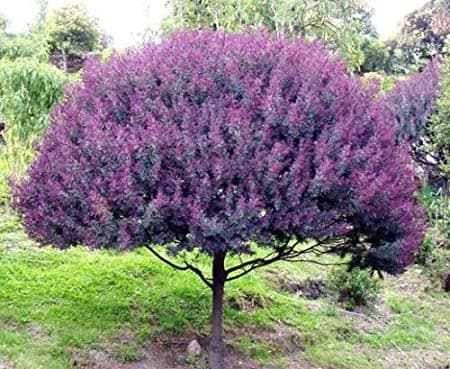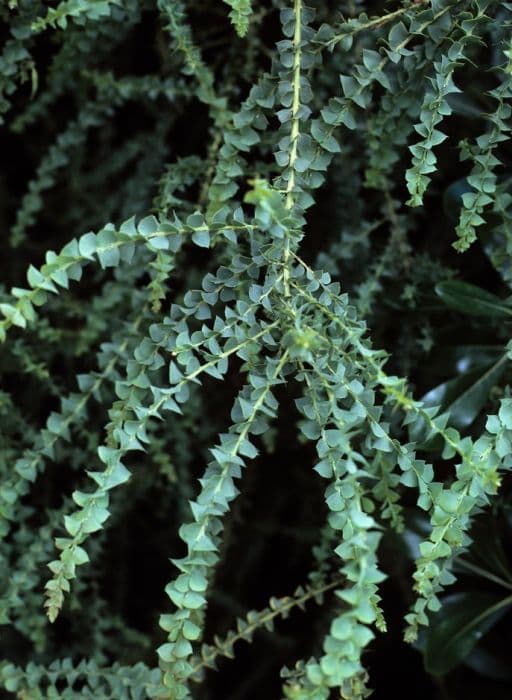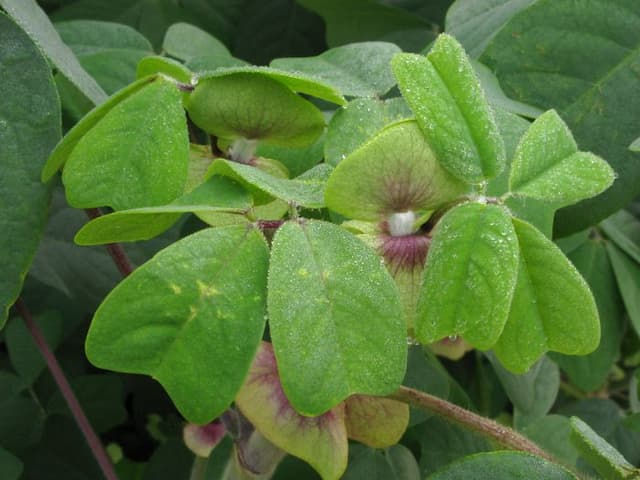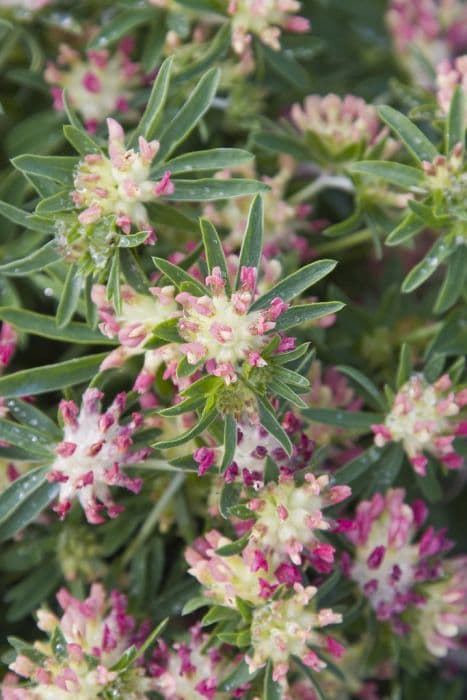Lupin Lupinus 'Masterpiece' (PBR)

ABOUT
Lupinus 'Masterpiece' is a vibrant and showy perennial plant, widely known as Lupine. It features trademark spires of richly colored flowers that have a gradient of hues ranging from deep purple at the base, transitioning to orangey-pink towards the tip, creating a stunning, almost flame-like effect. The flowers are densely packed on strong, upright spikes, offering a bold visual impact in any garden setting. The foliage of the Lupine 'Masterpiece' adds to its overall beauty, with palmate leaves that are comprised of several leaflets radiating out from a central point, much like the fingers on a hand. This gives the plant an attractive and somewhat tropical look even when it is not in bloom. The green of the leaves offers a striking contrast to the vibrant colors of the flowers, creating a lush backdrop that highlights the floral display. Overall, Lupinus 'Masterpiece' is recognized for these stunning floral spikes and ornamental foliage, which combine to create a dramatic and eye-catching presence in the landscape. Its appearance can bring texture, color, and vertical interest to garden beds and borders.
About this plant
 Names
NamesSynonyms
Lupin 'Masterpiece', Masterpiece Lupine.
Common names
Lupinus 'Masterpiece' (PBR)
 Toxicity
ToxicityTo humans
Lupins, including the variety 'Masterpiece', contain toxic alkaloids, primarily in the seeds, that can cause poisoning if ingested. Symptoms of lupin poisoning can include digestive upset such as nausea, vomiting, abdominal pain, and diarrhea. More severe reactions may involve tremors, dizziness, and respiratory issues. Ingesting lupin seeds can lead to alkaloid toxicity, which can have serious health consequences, and medical attention should be sought if poisoning is suspected.
To pets
Lupins, including the 'Masterpiece' variety, are toxic to pets and can cause similar symptoms as in humans if ingested. The alkaloids present in the plant can lead to poisoning, resulting in gastrointestinal upset, such as vomiting and diarrhea, and more severe cases can cause nervous system signs, like tremors or seizures. If a pet ingests lupins, it is important to contact a veterinarian promptly, as the toxicity can have serious and potentially life-threatening consequences.
 Characteristics
CharacteristicsLife cycle
Perennials
Foliage type
Deciduous
Color of leaves
Green
Flower color
Mixed
Height
3 feet (91 cm)
Spread
2 feet (61 cm)
Plant type
Herb
Hardiness zones
4
Native area
Mediterranean
Benefits
 General Benefits
General Benefits- Vibrant Color: 'Masterpiece' lupin produces rich, purple-red flower spikes that add striking color to any garden setting.
- Attracts Pollinators: The blooms attract bees, butterflies, and other beneficial insects, aiding in pollination.
- Vertical Interest: The tall spires of 'Masterpiece' lupin provide vertical interest and can be used to create depth in a mixed border or flower bed.
- Seasonal Interest: Blooms in late spring to early summer, offering seasonal color when many other plants are still developing.
- Herbaceous Perennial: A hardy perennial, it comes back year after year without the need for replanting.
- Dramatic Cut Flowers: The flower spikes make for excellent and long-lasting cut flowers for indoor arrangements.
- Cottage Garden Staple: Perfect for a traditional cottage garden look, providing a classic and romantic feel.
- Easy to Grow: Generally easy to care for and can thrive with basic garden maintenance.
 Medical Properties
Medical PropertiesThis plant is not used for medical purposes.
 Air-purifying Qualities
Air-purifying QualitiesThis plant is not specifically known for air purifying qualities.
 Other Uses
Other Uses- Erosion Control: The Lupinus, often called lupine, when planted on slopes, can help prevent soil erosion with its deep root system that holds the ground firmly.
- Nitrogen Fixation: Lupine has the ability to fix atmospheric nitrogen into the soil, which can improve soil fertility for surrounding plants in a garden or agricultural setting.
- Green Manure: Lupine can be used as a green manure when chopped and turned into the soil, providing organic matter and nutrients upon decomposition.
- Dye Production: The pigments found in lupine's flowers have historically been used to create dyes for textiles.
- Phytoremediation: Lupines can be used in phytoremediation to extract heavy metals from contaminated soils due to their absorbing capabilities.
- Companion Planting: Planting lupine near other crops can increase pollination rates for vegetables and fruits due to their attractive flowers that draw in bees and butterflies.
- Culinary Decoration: The vibrant blooms of the lupine can be used as natural decor to brighten up salads and other culinary presentations.
- Photography: Lupine's striking flowers make it a popular subject for garden photographers and nature enthusiasts.
- Wildlife Habitat: Lupine provides nectar for pollinators and can act as a larval host plant for some species of butterflies.
- Hideaway for Small Animals: The bushy structure of lupine plants can offer small animals and birds a hidden spot for nesting or protection.
Interesting Facts
 Feng Shui
Feng ShuiThe Lupine is not used in Feng Shui practice.
 Zodiac Sign Compitability
Zodiac Sign CompitabilityThe Lupine is not used in astrology practice.
 Plant Symbolism
Plant Symbolism- Imagination: The striking appearance of Lupinus 'Masterpiece', also known as Lupin or Lupine, with its vibrant colors and unique form, is often associated with creativity and a spark of inspiration.
- Innovation: Lupines are known for their ability to improve the soil by fixing nitrogen, which can symbolize an ability to enrich one's surroundings and introduce new, beneficial ideas.
- Transformation: The plant's ability to change bare landscapes into more fertile areas embodies the idea of positive transformation and personal growth.
- Devotion: In some flower language traditions, lupins represent an admiration for someone's qualities and a dedication to a relationship or cause.
 Water
WaterThe Lupine requires regular watering, especially during the growing season. Water at the base of the plant, avoiding overhead watering to prevent leaf diseases. Initially, water the plant once or twice a week, providing it with about 1 inch of water each time. As the Lupine establishes itself and matures, it can be watered less frequently; however, during hot, dry spells, increase watering to ensure the soil remains moist but not waterlogged. During winter months, reduce watering significantly, but don't allow the soil to completely dry out.
 Light
LightLupines thrive in full sunlight, requiring a minimum of 6 hours of direct sunlight daily to flourish. Place them in a location where they receive plenty of morning light and, if possible, some afternoon shade in areas with very hot summers. Avoid deep shade, as this will reduce blooming and can encourage fungal diseases due to lack of proper sun exposure.
 Temperature
TemperatureLupines prefer cooler temperatures and will thrive in conditions between 60 to 75 degrees Fahrenheit. They can survive minimum temperatures down to about 20 degrees Fahrenheit, but extended periods below freezing can damage or kill the plant. The ideal temperature range for robust growth and flower production is between 60 and 70 degrees Fahrenheit.
 Pruning
PruningPrune Lupines to encourage repeat blooming and to maintain plant health. Deadhead spent flower spikes after the first bloom has finished to stimulate a second blooming cycle. At the end of the growing season, cut the foliage back to the ground to promote healthy growth in the spring. The best time for pruning is immediately after the first flowering ends and again in late fall or early winter.
 Cleaning
CleaningAs needed
 Soil
SoilThe Masterpiece Lupin thrives in slightly acidic to neutral soil, with an optimal pH range of 6.0 to 7.0. A well-draining soil mix comprising of garden loam, peat, and sharp sand is ideal. Ensure the soil is rich in organic matter to promote vigorous growth and flowering.
 Repotting
RepottingLupins, including the Masterpiece Lupin, generally do not need frequent repotting and can be left undisturbed for several years. They may only require repotting if they outgrow their current container or if the soil needs replenishment, typically every 2-3 years.
 Humidity & Misting
Humidity & MistingMasterpiece Lupins prefer moderate humidity levels but are quite adaptable and can tolerate the humidity found in most garden environments. They do not require any special humidity considerations, making them suitable for a typical outdoor setting.
 Suitable locations
Suitable locationsIndoor
Maintain bright light and cool temps for indoor Masterpiece Lupin.
Outdoor
Plant in full sun; enrich soil with compost for outdoor Masterpiece Lupin.
Hardiness zone
4-8 USDA
 Life cycle
Life cycleLupinus 'Masterpiece', commonly known as Masterpiece Lupine, begins its life as a seed which, when sown in well-drained soil and exposed to the cool temperatures of early spring or fall, will germinate and sprout. The seedling stage is characterized by the appearance of the plant's first true leaves after the initial cotyledons, establishing a root system and beginning photosynthesis. As the plant enters the vegetative stage, it rapidly produces more leaves, establishing a rosette, and stores energy in preparation for flowering. The reproductive stage occurs when the plant sends up a flowering spike, typically in late spring or early summer, showcasing tall, vibrant, and colorful spires of pea-like flowers that attract pollinators. After pollination, the lupine sets seed pods, which mature, dry, and eventually release seeds, thus completing the cycle. In cold climates, lupines are perennial, dying back to the ground in winter and regrowing from the rootstock the following spring, whereas, in warmer regions, they may complete their life cycle within a year.
 Propogation
PropogationPropogation time
Spring-Early Summer
Commonly known as Lupine, Lupinus 'Masterpiece' (PBR) is often propagated by seed. The ideal time to sow seeds is in late winter or early spring, as this coincides with the natural germination period for many perennial plants. To propagate Lupine by seed, you first need to scarify the seeds, which involves scratching or nicking the seed coats to improve water absorption. After scarification, the seeds are usually soaked in water for about 24 hours to further help break down the tough outer coating. The seeds are then sown in a well-draining soil mix, either in a greenhouse or under cloches if outdoor temperatures are not yet suitable. It's important to maintain a consistent moisture level after sowing but to avoid waterlogging, as Lupine seeds can rot in excessively wet soil. Seedlings usually emerge in 14 to 28 days, and after a few sets of true leaves develop, they can be transplanted to their final growing positions.









